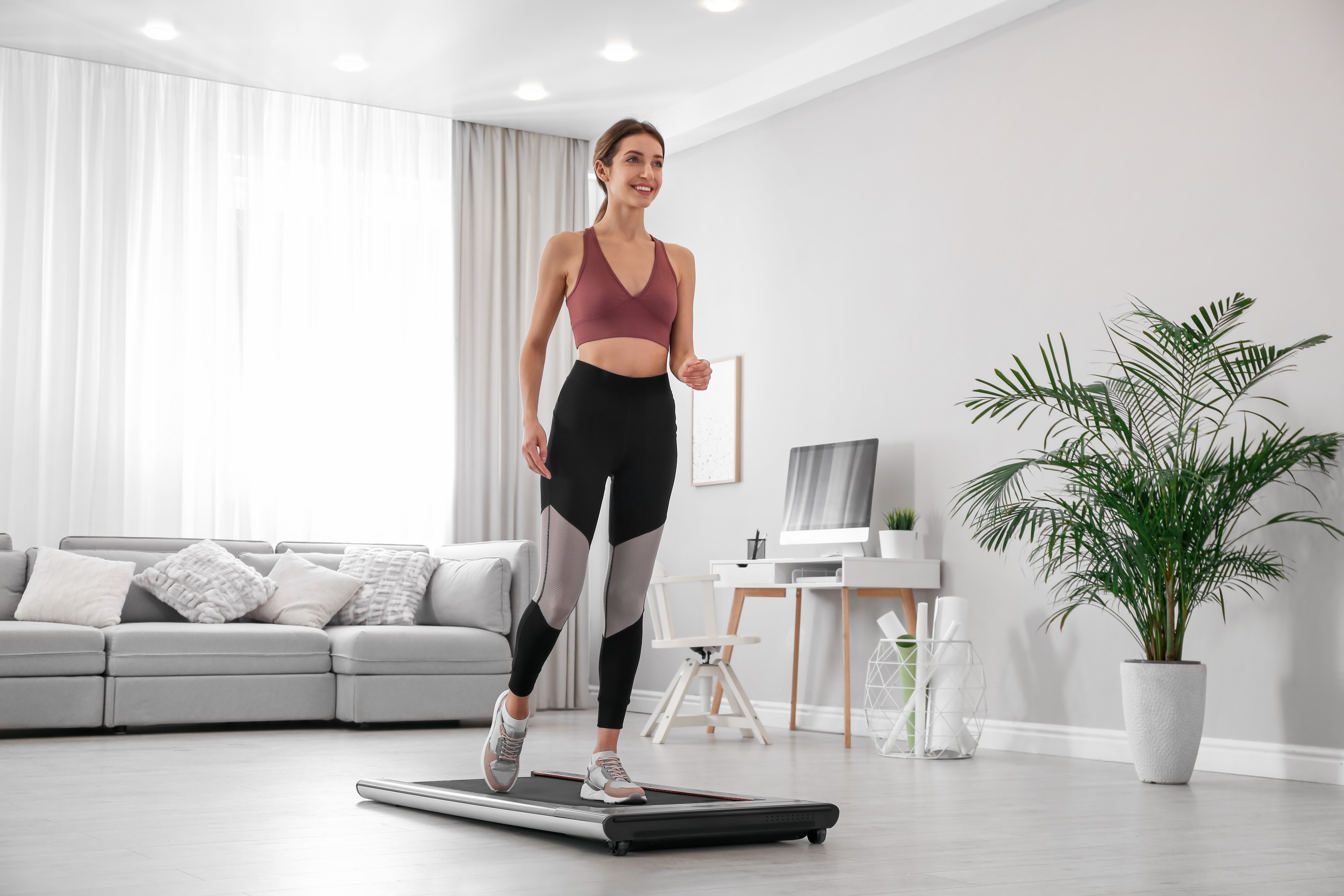13 Easy Ways to Walk 10,000 Steps a Day to Lose Weight & Live Longer

Walking 10,000 steps a day isn’t just a trendy fitness goal—it’s a simple yet powerful way to supercharge your health.
Research shows that consistently hitting this number can help you shed unwanted pounds, improve cardiovascular health, and even add years to your life. A 2022 study published in JAMA Internal Medicine found that walking 7,000–10,000 steps daily was associated with a 50-70% lower risk of mortality. What’s more, according to a joint 2020 report from the Centers for Disease Control and Prevention (CDC), National Cancer Institute (NCI), and National Institute on Aging (NIA), the more steps you take, the greater the health benefits can be.
Getting your steps on a daily basis can improve your mood, strengthen bones, and rev up your metabolism, making it one of the easiest and most effective ways to enhance both your body and mind. You don’t necessarily need a gym membership or treadmill to hit your step goal either, so whatever excuses you can come up with, it’s time to toss ’em.
Whether you choose to pace your office during phone calls, take a leisurely stroll through the neighborhood, or find ways to tack on extra steps during everyday activities, there are plenty of easy ways to reach 10K daily—and love the process! Here are some expert-backed suggestions to get started today, and walking will soon become your secret weapon for better health, a leaner body, and a longer, happier life.
RELATED: The 6 Best Shoes for Walking, According to Podiatrists
1
Schedule your walking sessions ahead of time.

For many people, the biggest roadblock to walking more often is finding the time. To face this head-on, schedule your steps in advance, says Rose McNulty, a NASM-certified personal trainer and NASM-certified nutrition coach.
“A schedule that’s feasible to stick to is crucial for staying on track,” McNulty says. “For an average person, 10,000 steps is about five miles, and a typical pace is about three miles per hour,” McNulty explains.
This means that, if you’re typically a sedentary person, you should allocate about 1.5 to 2 hours a day to walking.
“Even if you didn’t take many steps throughout the rest of the day, you’d be more than halfway to 10,000 in about an hour,” says McNulty. “Pick up the pace a bit, and you could walk a full five miles in less than one and a half hours.”
2
Wear a pedometer or fitness tracker.

People who regularly walk 10K a day swear by their trackers to measure their progress and make it more tangible.
“Fitbits and other wearable devices make this super easy and fun,” says Mary Sabat, MS, RDN, LD, a nutritionist and Ace Certified Trainer. “They provide a visual representation of your progress and motivate you to reach your daily goal.”
If you don’t have an hour or two to devote to just walking, tracking can also help you budget your steps throughout the day so that they’re spread out in manageable chunks.
For example, by aiming for four half-hour walks throughout the day, you should easily hit your 10,000 step goal.
RELATED: 20 Amazing Health Benefits of Walking
3
Get to stepping early in the day.

Alex Stone, DPT, CSCS, a Doctor of Physical Therapy and Certified Strength and Conditioning Specialist, says getting your steps in early can make you more likely to reach your daily goal by the end of the day. That’s why it’s a great idea to kickstart each morning with a stroll soon after waking up. “This not only helps to boost your metabolism and energy levels, but also puts you on the path to accomplishing your daily step goal early on,” he says.
Not motivated to get moving first thing in the morning? Go explore different routes or scenic locations, Stone suggests. “This will make your daily walks more enjoyable and easier to maintain as a habit.”
4
Walk in place while doing mundane tasks.

Brushing your teeth? Cooking dinner? Folding laundry? Pick up those feet and walk in place to rack up more steps!
This genius tip is from TikToker @ffgcoaching, who lost over 70 pounds mainly due to walking. She shares her best and most realistic weight loss advice for people over 40 via her account.
In a recent TikTok video, she demonstrates how she marches while vacuuming her house, making tea, talking on the phone, and doing just about any chore to easily get to 10,000 steps a day. So smart.
5
Hop on the treadmill for quicker sessions.

If you’re short on time but high with motivation, you can hit 10K steps quicker with dedicated treadmill time.
“Try incorporating jogging or running as cardio,” suggests McNulty. “Both of these activities will help you hit your step goal quicker than walking, so this is a good option for those with sedentary jobs who don’t have much time outside of work.”
6
Enlist a walking buddy.

Turning your walk into a social activity may make you more likely to stick to—and even look forward to—your routine. Stone recommends taking post-dinner strolls with your loved ones.
“This promotes bonding while also helping everyone stay active and achieve their step goals,” he says. If you plan to take your walks solo, even phoning a friend while walking can enhance the experience.
RELATED: 9 Simple Tricks to Burn Fat on a Walk
7
Get up and move around during work breaks.

Sitting all day can be uniquely hazardous to your health. In fact, according to the World Health Organization, being sedentary is a leading cause of death and disability worldwide. If you’re parked at a desk all day, plan on taking a short walk every hour or so to counteract the effects of sitting for long periods of time.
“Use your lunch or shorter breaks throughout the day to take quick walks around your office building or a nearby park,” advises Stone. “This not only contributes to your step count but also helps refresh your mind and reduce work-related stress.”
Use your smartphone or fitness tracker to set reminders. “This will encourage you to stay consistent and prevent long periods of inactivity,” he says. Some, like the Apple Watch, even nudge you to stand and walk around.
8
Invest in a walking pad.

Walking pads have exploded in popularity in recent years for the exact reason you want to walk more: Science has proven the health and wellness benefits are too good to pass up.
Sold on sites like Amazon and Walmart, walking pads run anywhere from $100-$500, but are worth the investment. Slide one under your standing desk to log miles while you’re working on your computer. Or, situate one front and center in your living room to hit 10K easily while watching your favorite TV shows.
9
Take the stairs whenever possible.

Not all steps are created equal—some are extra effective at building muscle strength and cardiovascular endurance. When you’re climbing a flight of stairs, for example, you stand to gain more health benefits per step than you do walking down the street. “
Whenever possible, opt for the stairs instead of elevators or escalators,” Stone recommends.
If you’re a gym-goer, you can end your strength sessions with a few minutes on the stairclimber to get your steps in, too.
10
Park farther away from your destination.

City dwellers have walks built in to the daily life, but if you live in a suburban or rural area, driving may eliminate those walking sessions. Still, you can add steps to your routine by parking farther away from your destination whenever possible.
If you need to run multiple errands in a walkable area, plan on parking centrally and walking from one errand to the next. “This simple strategy forces you to walk more and increases your daily step count without much thought,” says Stone.
RELATED: The 6 Best Walking Workouts for Weight Loss
11
Be accountable to others.

Sharing your steps with a friend or even strangers online can fuel your walking motivation.
“Even if you don’t live near anyone who wants to walk or exercise with you, there are plenty of smartphone apps that make a game out of stepping and let you share your progress,” says McNulty. “Try downloading one and enlisting some friends to challenge themselves with you, and hold each other accountable each day,” she suggests.
12
Start a weekend hiking habit.

This is an excellent two-for-one idea. Whether solo or with a partner, you can commit to making hiking your new hobby on weekends.
Trail walking in nature is incredible for your mind and body, and you can do it practically any time of year, so long as you follow obvious safety measures.
Not only will you hit 10,000 steps easily during your trek, but hiking engages different muscle groups, leading to improved muscle tone and strength. It’s also an effective calorie-burning activity that aids in weight loss and maintaining a healthy weight.
13
Walk your dog three times a day.

This may sound excessive, but consider it, because it’s an effective way to easily crush 10,000 steps a day. And, your dog will love you for it.
Simply plan to walk your dog (or yourself) for 30 minutes in the morning, 30 minutes in the afternoon, and 30 minutes at night, and you will have hit your goal. To remember, you can head out for a stroll after breakfast, lunch, and dinner.
RELATED: The Best Dogs to Walk (and Run) With
Studies have shown that leisurely or moderate-paced walks after mealtime offer a slew of health benefits, including improving your digestion, regulating blood sugar, burning calories, reducing heart disease risk, boosting your mood, and more.
This is why getting your steps in every day is so vital for your body. It helps keep you slim, fit, and living as long as possible.